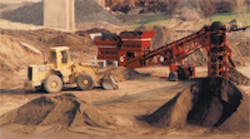Spent Sands Find Practical, Commercial Use in Soil Blending
In 1986, Kurtz Bros. Inc. responded to the need for recycling spent foundry sand at Ford Motor Co.’s Cleveland Casting Plant. The automaker wanted a different approach for handling the necessary material than its simple practice of landfilling its spent foundry sand. Since beginning its partnership with Ford, KB has “beneficially reused” over 6 million tons of spent foundry sand in a variety of ways.
One important application at Kurtz Bros. is blending the spent sand into “manufactured soil” to be used as a replacement for natural topsoil. Natural topsoil, which may take thousands of years to build up, has been stripped away by urban development, mining, and erosion. Also, once excavated and stockpiled, the remaining soil often no longer has the structural foundation necessary for good plant growth.
The disappearance of natural topsoil poses a significant challenge to landscape architects, civil engineers, and developers in many areas — and creates an opportunity for foundries using sand as a molding medium. The solution/opportunity in many cases is to blend spent foundry sand with other materials into manufactured soil. Foundry sands have excellent physical properties that can be used by commercial soil blenders. Research by the U.S. Dept. of Agriculture and U.S. EPA confirms that properly managed ferrous and aluminum foundry sands can be used safely in soil blending operations.
At seminar last summer in Columbus, OH, organized by Foundry Industry Recycling Starts Today (FIRST; www.foundryrecycling.org), foundrymen and others learned about this and other developing applications for used foundry sand.
FIRST is a centralized resource for technical information on recycling spent foundry sand.
One of the seminar speakers was Dr. Elizabeth Dayton, who reviewed the results of nearly 20 years of investigation on foundry sand in soil applications at The Ohio State University. She outlined the characteristics of foundry sand that make it a good ingredient for soil blending, as well as some of the soilsbased applications that have potential for foundry sands.
According to Kurtz Bros.’ Greg Malone, the company started more than a decade ago to develop markets for foundry sands in soils applications, and as a result has become a leader in the field. Today, the company blends approximately 250,000 yards of soils each year.
Blended soils are used by landscape contractors, state, and municipal governments, commercial developers, and consumers. Kurtz sells the soil blends through distributors and to landscape contractors, nursery growers, and municipal and commercial projects, as well as direct to consumers. And, Malone explained why that recycling effort is worthwhile.
For example, distributors account for 40% of soil volume sold. In general, their markets are made up of consumers (80-85%) and wholesale landscape contractors (15-20%). The average delivered- cost to the distributor is $16-18/ yard, and the average retail selling price is $26-28/yard.
Landscape contractors account for 45% of the volume of soil sold. In general, those markets include consumer installation projects (+90%) and commercial installation projects (±10%). The average picked-up cost to the landscape contractor is $17-20/yard, while the average installed price is $50-60/ yard. Malone pointed out that spent foundry sands also can be used as structural fill and backfill, and in embankment construction and production of concrete barriers.
Dan McKeown, from Unicast Co., a gray iron foundry in Boyertown, PA, reported that his company expects to recycle 850 tons of used sand into soil blending in 2008-2009.
Many of the detailed presentations of the FIRST seminar can be accessed at www.foundryrecycling.org.
